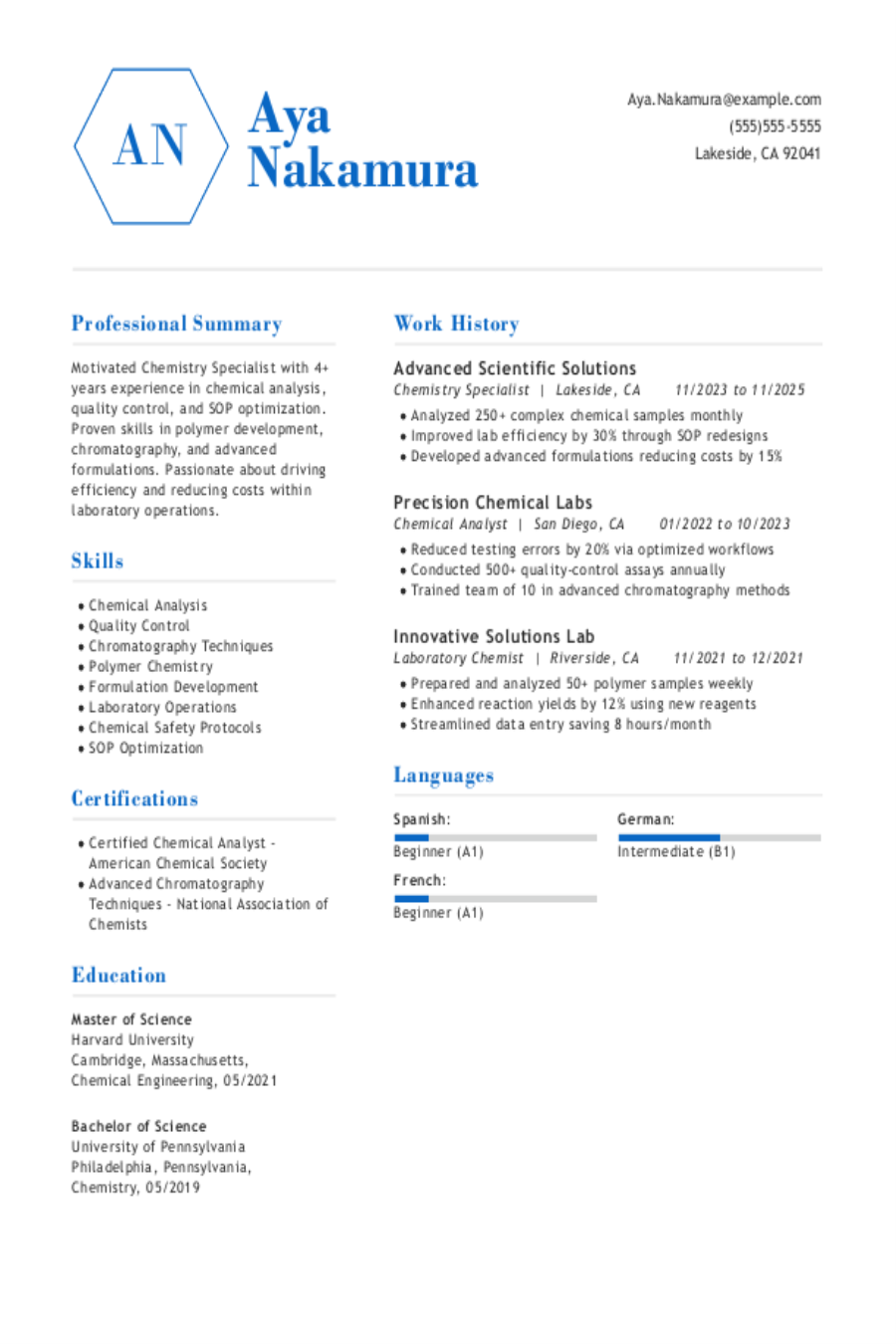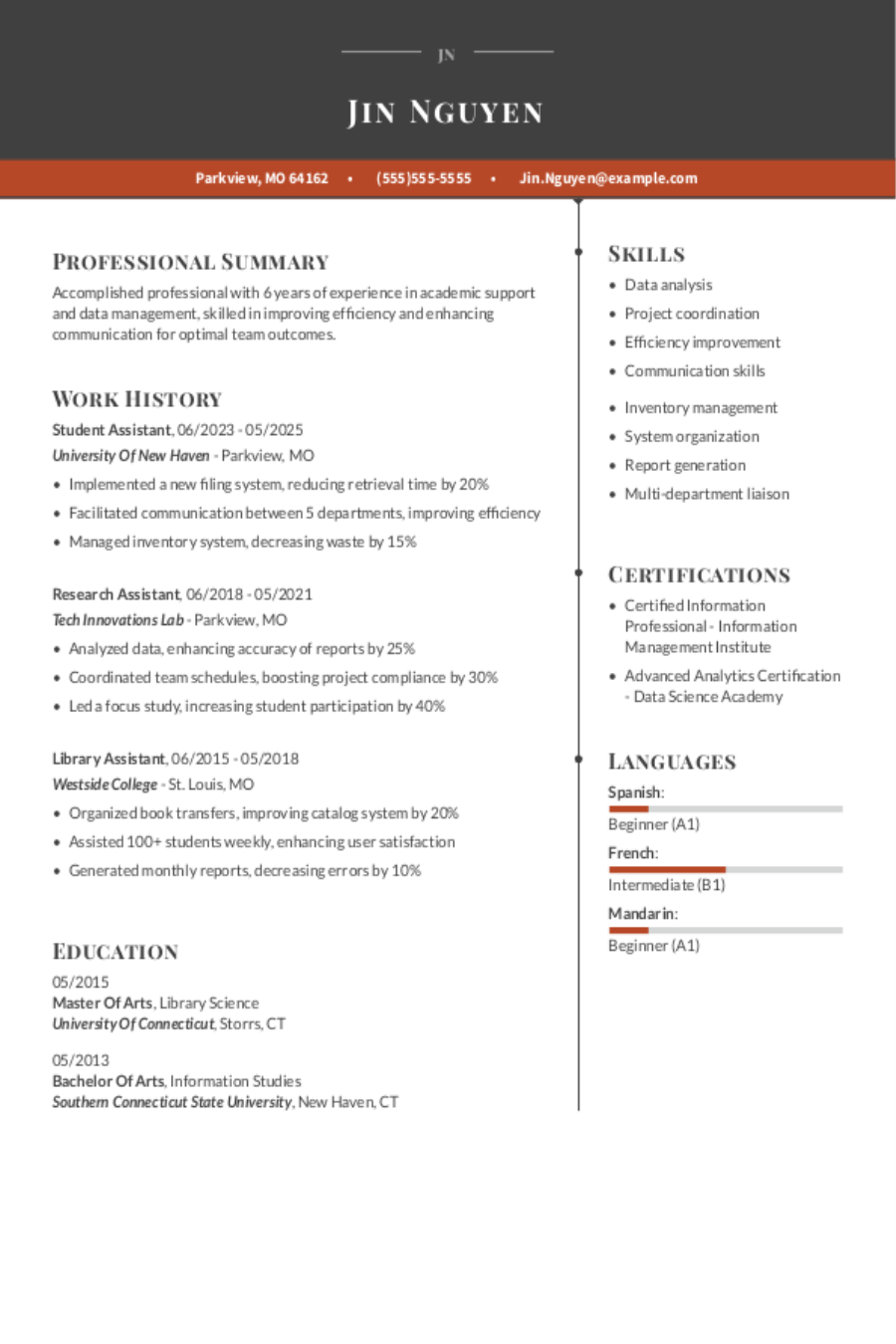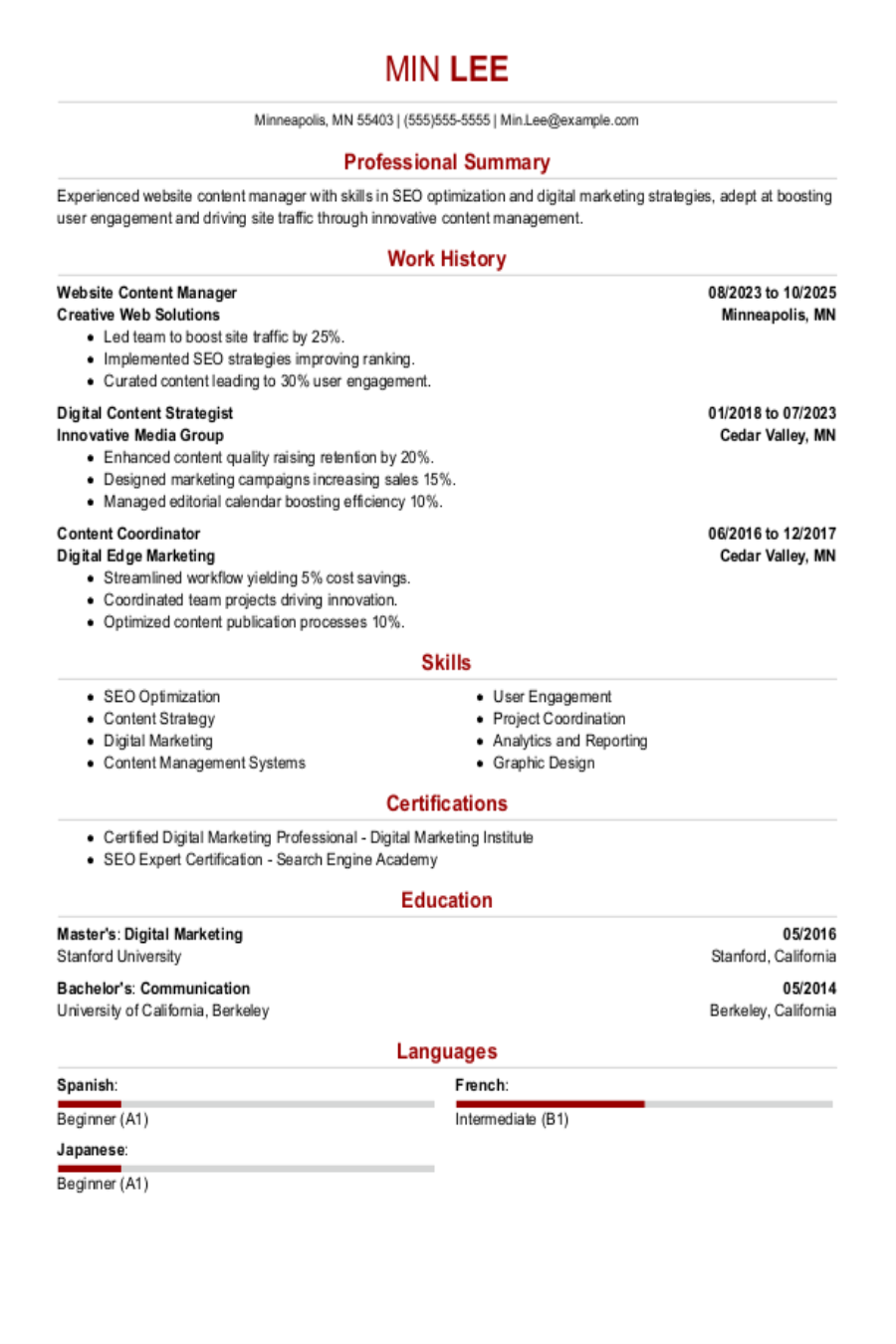Table of contents
Popular Microbiologist Resume Examples
Entry-level microbiologist resume
An entry-level resume for a microbiologist should highlight relevant coursework, laboratory skills, internships, certifications, and research experience to showcase knowledge and potential contributions even with a limited professional background.
Focuses on goals: The applicant demonstrates a proactive approach to professional growth as a microbiologist, significantly improving lab protocols and data analysis efficiency while engaging in continuous learning through certifications and hands-on experiences.
Emphasizes skills: This resume highlights the job seeker's strong soft skills along with critical technical skills. Focusing on skills helps their resume shine despite limited experience.
Mid-career microbiologist resume
A mid-career microbiologist's resume should emphasize a strong combination of practical laboratory experience, technical skills, and ongoing professional development to effectively demonstrate their expertise and contributions to the field.
Employs active language: Powerful action verbs such as "led," "improved," and "optimized" effectively illustrate strong contributions and proactive leadership in microbiological research initiatives.
Opens with a powerful professional summary: A strong professional summary highlights this candidate's extensive experience as a microbiologist, showcasing key accomplishments such as improving lab efficiency and accuracy. This clarity ensures that both recruiters and ATS can swiftly recognize your qualifications.
Experienced microbiologist resume
An experienced microbiologist's resume should prioritize highlighting significant research contributions, laboratory skills, and relevant certifications to effectively demonstrate their expertise and career advancement in the field of microbiology.
Optimized for ATS: The resume uses a polished template that features a professional header alongside an ATS-friendly resume format, ensuring optimal visibility for both human recruiters and automated systems during the hiring process.
Embraces a modern style: This modern resume template effectively highlights the applicant's innovative approach to microbiology, showcasing their commitment to research excellence and efficient laboratory practices that drive effective scientific discoveries.
No experience microbiologist resume
A resume for an applicant with no experience should highlight relevant coursework, laboratory skills, and any volunteer or internship experiences that showcase a commitment to the field and an eagerness to learn.
Leads with education: As a candidate with no concrete experience, emphasizing academic achievements and education helps lend this resume credibility.
Uses a simple style: The resume's clean design effectively highlights relevant qualifications and experiences, making it easy to see the job seeker's dedication to microbiology and community service without unnecessary clutter.
More resume examples
Microbiologist Resume Template
Kickstart your career with this microbiologist resume template, designed to help you showcase your skills and experiences. Simply personalize it with your own details to make it uniquely yours.
Li Kim
Springfield, IL 62702
(555)555-5555
Li.Kim@example.com
Professional Summary
Experienced microbiologist with 8 years in microbial analysis and research. Skilled in DNA sequencing, lab management, and protocol optimization. Proven track record in publishing influential studies and improving lab efficiency.
Work History
Microbiologist
BioTech Solutions - Springfield, IL
August 2019 - August 2025
- Conducted microbial analysis increasing accuracy by 25%
- Managed lab equipment reducing downtime by 15%
- Optimized protocols resulting in 35% faster results
Research Biologist
Genomics Innovations - Springfield, IL
August 2015 - July 2019
- Developed DNA sequencing methods improving accuracy by 20%
- Collaborated on projects reducing costs by K
- Published findings in journals influencing 10 studies
Bio Laboratory Technician
Advanced BioWorks - Springfield, IL
August 2012 - July 2015
- Assisted in experiments boosting efficiency by 30%
- Managed inventory cutting waste by 20%
- Documented procedures enhancing training by 25%
Skills
- Microbial analysis
- DNA sequencing
- Lab management
- Protocol optimization
- Research collaboration
- Scientific writing
- Data interpretation
- Experimental design
Education
Master of Science Microbiology
University of Illinois Urbana-Champaign, Illinois
May 2012
Bachelor of Science Biology
University of California Berkeley, California
May 2010
Certifications
- Certified Microbiologist - American Society for Microbiology
- Laboratory Safety Certification - University of Illinois
Languages
- Spanish - Beginner (A1)
- French - Beginner (A1)
- German - Intermediate (B1)
Must-Have Skills on a Microbiologist Resume
A strong skills section is important for showcasing your qualifications and making a positive impression on potential employers.
The following data highlights the most sought-after hard and soft skills for microbiologists sourced from Resume Now’s extensive resume database.
When you’re ready to improve your resume with relevant skills, check out our AI Resume Skills Generator. It offers tailored skill suggestions based on your specific job title, enabling you to create a comprehensive and customized skill set.
Writing Your Microbiologist Resume
Having explored these effective resume examples, you're now prepared to dive into the detailed process of how to write a resume. We'll take you through each section step by step, ensuring you craft a compelling document that showcases your skills and experience effectively.
List your most relevant skills
An effective skills section on your microbiologist resume is important for showcasing your qualifications and suitability for the role. By directly addressing the required technical skills—such as laboratory techniques, data analysis, and knowledge of microbial genetics—you can present yourself as a strong applicant. It's important to tailor this section by incorporating keywords from the job listing, which not only appeals to human recruiters but also improves your visibility in applicant tracking systems (ATS).
Using keywords from the job listing will help demonstrate how you align with their requirements while ensuring that ATS recognizes you as a qualified applicant.
Example of skills on a microbiologist resume
- Proficient in conducting microbiological tests and analyses to identify pathogens
- Skilled in maintaining laboratory equipment and ensuring compliance with safety protocols
- Strong communicator with a collaborative approach to research projects
- Detail-oriented with excellent data analysis and interpretation skills
Including both hard and soft skills in your skills section demonstrates your ability to tackle technical tasks while also thriving in team environments. For instance, skill in lab techniques paired with strong communication skills makes you an invaluable asset.
Highlight your work history
Your work experience section is where you can showcase your achievements and demonstrate how you've applied scientific skills in practical settings. Focus on specific projects or research findings, and ensure you incorporate relevant keywords that align with the job description to draw the attention of hiring managers.
For each job entry, include your title, the employer's name, and the dates of employment to provide context for your background and establish credibility as a professional. It's important to highlight quantifiable outcomes—such as publications or successful experiments—that reflect your contributions to advancing the field.
Example of a microbiologist work experience entry
- Microbiologist
BioTech Solutions - San Diego, CA
June 2019 - Present - Conduct detailed research on microbial cultures and their applications in biotechnology to innovate product development strategies
- Use advanced microscopy techniques to analyze bacterial samples, achieving a 98% success rate in identifying pathogenic strains
- Lead cross-functional teams in designing experiments that adhere to safety regulations and quality standards, improving lab efficiency by 30%
- Mentor junior microbiologists and interns through hands-on training sessions, improving team knowledge base and fostering professional growth
- Publish findings in peer-reviewed journals, contributing to the body of scientific knowledge and raising the company’s profile within the industry
Aim for clarity in your resume bullet points by being concise yet informative. Focus on specific achievements and quantify results where possible, ensuring each statement adds value without overwhelming the reader with unnecessary details.
Include your education
The education section of your microbiologist resume should present your academic credentials in reverse-chronological order, starting with your most recent degree. It's essential to include relevant degrees and certifications while omitting high school diplomas if you hold a bachelor's degree or higher. Highlighting any honors or specific coursework related to microbiology can also improve this section.
If you are currently pursuing a degree or have an incomplete education, be sure to list your highest completed level along with an expected graduation date. For those who are students or recent graduates, including bullet points that detail relevant coursework, research projects, or academic achievements can bolster your credibility.
Common certifications for a microbiologist resume
- Certified Microbiologist (CM) – American Society for Microbiology (ASM)
- Registered Microbiologist (RM) – National Registry of Microbiologists (NRM)
- Clinical Microbiology Certification (CMC) – American Society for Clinical Pathology (ASCP)
- Diplomate in Laboratory Management (DLM) – American Society for Clinical Pathology (ASCP)
Showcase publications and research
As a microbiologist, showcasing your publications section on your resume is essential for establishing your expertise and authority in the field. Publications reflect not only your research capabilities but also your commitment to advancing scientific knowledge. They serve as tangible proof of your contributions and can set you apart from other job seekers by highlighting your achievements in peer-reviewed journals or conferences.
When deciding how to present your publications on your resume, consider creating a dedicated publications section if you have several noteworthy entries. This allows prospective employers to easily identify your contributions. Conversely, integrating them into sections like education or relevant experience may suffice if you only have one or two significant publications. Ensure you use the appropriate citation style common in microbiology (such as APA) for consistency and professionalism.
Example of a publications section
- Smith, J. & Doe, R. (2024). "Microbial Diversity in Urban Soils". Journal of Microbiology Research, 45(3), 120-135.
- Johnson, A., Lee, T., & Brown, M. (2023). "Impact of Antibiotic Resistance on Public Health". Global Health Journal, 10(1), 55-72.
- Research Contributor, National Microbiome Initiative (2022–2023). "Research Contribution to the Human Gut Microbiome Project". Analyzed microbial samples from diverse populations.
- Chen, H., Johnson, A., et al. (2022). "Collaborative Study on Soil-Borne Pathogens". Applied Environmental Microbiology, 88(4), e01234.
Sum up your resume with an introduction
Your resume profile serves as your personal introduction. It’s your chance to succinctly convey your career focus and set the tone for what follows in your resume.
For seasoned applicants with extensive experience, using a professional summary is ideal. This format allows you to showcase key achievements and qualifications right at the top, enabling hiring managers to quickly gauge your expertise. Less experienced candidates should write a goals-focused resume objective that highlights your career development and goals.
Professional summary example
Dedicated microbiologist with over 5 years of experience in clinical and research settings. Demonstrated expertise in microbial analysis, pathogen identification, and laboratory techniques, contributing to innovative solutions that improve public health. Proficient in data interpretation and report generation, ensuring accurate results that support decision-making processes across interdisciplinary teams.
Resume objective example
Enthusiastic microbiologist eager to apply a solid foundation in laboratory techniques and data analysis to support innovative research projects. Committed to using strong problem-solving abilities and attention to detail to improve experimental outcomes and contribute effectively to a collaborative scientific team.
As a microbiologist, it's essential to begin with your resume profile by including your job title. This approach not only highlights your professional identity but also allows employers to quickly understand your expertise and the value you bring to their organization.
Add unique sections to set you apart
Including optional resume sections can greatly improve your application for microbiologist positions by highlighting your unique qualifications. These additions allow you to stand out and show potential employers the diverse skills and experiences you bring to the table.
These sections can reveal different facets of your professional life, such as relevant hobbies or volunteer work that align with your values. For instance, if you've participated in community health initiatives or conducted research in environmental microbiology during your free time, these experiences not only demonstrate your passion but also showcase transferable skills like teamwork and problem-solving. By sharing these insights, you give employers a more comprehensive view of who you are as a applicant.
Three sections perfect for a microbiologist resume
- Laboratory techniques: Highlighting your skill in laboratory techniques is important for a microbiologist. Include specific methods you've mastered, such as PCR, plating techniques, or microscopy, and any relevant applications or outcomes from your work.
- Publications and presentations: Showcasing your contributions to scientific literature and conferences emphasizes your active role in the field. List peer-reviewed articles, conference presentations, or posters that reflect your research impact and engagement with the scientific community.
- Collaborative projects: Demonstrating your ability to work on interdisciplinary teams illustrates your adaptability and teamwork skills. Provide examples of collaborative endeavors, including roles you played and the significance of the projects in advancing microbiological knowledge.
5 Resume Formatting Tips
- Choose a format that matches your career stage.
When crafting your resume as a microbiologist, consider your experience level. If you have extensive experience in the field, a chronological resume format highlights your career progression effectively.
If you're just starting out or transitioning from another discipline, a functional resume can emphasize your skills and relevant coursework. For those with a mix of both experiences, the combination format allows you to showcase the best of both worlds. - Pick a smart resume template.
To improve the readability and formatting of your resume as a microbiologist, consider using a professional resume template. This approach not only streamlines your information for quick comprehension but also ensures that your document is compatible with applicant tracking systems (ATS). Choose a layout that showcases your skills and accomplishments clearly, making it easier for hiring managers to see why you’re an ideal job seeker.
- Select an appropriate font.
When crafting your resume, it's important to opt for clean and professional fonts like Arial, Calibri, or Garamond. These fonts improve readability for both applicant tracking systems (ATS) and hiring managers, ensuring your qualifications stand out without distraction.
- Use consistent formatting.
Ensure your resume is neatly aligned, with uniform margins on all sides. This creates a polished and professional look that improves readability and leaves a positive impression.
- Keep your resume to one or two pages.
When crafting your resume, remember that resumes should be one page long for most job seekers. This approach helps present your qualifications clearly and effectively. If you have extensive experience, a two-page format is acceptable, but ensure every word serves a purpose to maintain conciseness.
What’s the Average Microbiologist Salary?
Microbiologist salaries vary based on location, career level, and qualifications.
This data, provided by the Bureau of Labor Statistics, will show you expected salary ranges for microbiologists in the top 5 highest-paying states, including the District of Columbia. The figures reflect the most current salary data available, collected in 2024.
- Full Range
- Most Common (25th–75th percentile)
- Average
Massachusetts
Most common: $99,900 - $134,530
California
Most common: $93,310 - $134,260
Maryland
Most common: $77,510 - $131,500
Georgia
Most common: $77,470 - $123,840
Montana
Most common: $61,110 - $132,120
Tools for Your Job Search
Are you ready to advance your career as a microbiologist? Before you submit your application for that exciting position, consider leveraging our ATS Resume Checker. This essential tool provides insights into how effectively your resume aligns with the automated systems that many research institutions and laboratories use for initial applicant screenings.
If you're looking to elevate your application further, our AI Resume Builder can help. This tool offers tailored recommendations that highlight your unique qualifications and experiences, alongside professionally designed templates specifically crafted for the scientific field.
Frequently Asked Questions
Last Updated: September 19, 2025
Absolutely. A cover letter is important because it adds depth to your resume, giving you the chance to convey your enthusiasm for the role and highlight how your unique background makes you a great fit. This document fosters communication with potential employers, allowing you to connect on a personal level. So don’t hesitate—write a cover letter that showcases your passion and qualifications.
For an efficient solution, consider using our AI Cover Letter Generator, which allows you to create a tailored cover letter in just minutes. With various cover letter template options available that align perfectly with your resume, you'll ensure a polished and professional presentation of your expertise as a microbiologist.
A CV (curriculum vitae) is generally more extensive and detailed than a resume. While resumes are typically concise, spanning one to two pages, CVs can extend over several pages, offering comprehensive insights into your academic history, research contributions, publications, and professional experiences.
You’ll often need a CV for roles in academia, science, or specialized fields like law or medicine. If you find yourself in this situation, our online CV Maker is here to help! With various CV templates tailored for different industries and career levels, creating a polished and effective CV has never been easier. Start crafting your standout document today!
A microbiologist's resume should ideally be one page long, as this is usually sufficient to highlight relevant skills and experiences. However, for those with extensive backgrounds or specialized qualifications, a two-page resume may be appropriate to better showcase their achievements and contributions in the field.
To stand out as a microbiologist, select a modern, professional resume template. Tailor your content by integrating relevant keywords from the job description to demonstrate your expertise and alignment with the desired qualifications.
When crafting your skills section as a microbiologist, ensure you highlight both technical competencies, like laboratory techniques and data analysis software, alongside soft skills such as communication and teamwork. In your experience section, illustrate how these skills were applied in research projects or clinical settings to achieve significant results.
To improve your networking skills as a microbiologist, regularly connect with former colleagues and peers to share insights and opportunities. Consider joining professional organizations like the American Society for Microbiology. Additionally, ensure your LinkedIn profile is current to stay visible within the industry and engage with relevant content that showcases your expertise.
Was this information helpful? Let us know!
Leisha is a career industry editor dedicated to helping job seekers excel in their careers.
More resources

How to Include Networking Skills on a Resume (40+ Examples, Definition & Tips to Improve)
What are networking skills? We ll answer this and all your p...

RoboBossing: 66% of Workers Say AI in Leadership Would Make the Workplace More Fair and Efficient
Resume Now s latest report finds growing support for thoughtfu...

How to Write a Resume for a Career Change
Need a resume to showcase your unique career path? Our guide c...

Chemistry Resume: Examples, Templates & Tips
Make a chemistry resume that gets interviews. Use our writing ...



